Around the World
July/August 2021
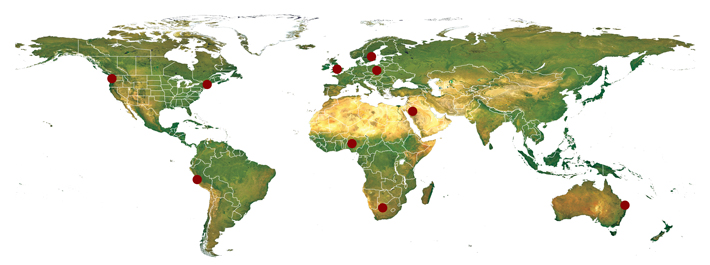

-
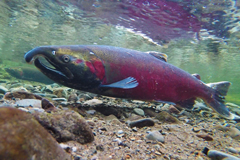 WASHINGTON: Salmon is an excellent source of lean protein, but eating too much of it isn’t healthy. It has long been thought that Indigenous populations of the Pacific Northwest ate an almost exclusively salmon-based diet yet were somehow unaffected by “salmon starvation,” a toxic condition caused by an overly protein-intensive diet. A new study suggests that Native communities were well aware of these nutritional pitfalls and relied on trade, hunting, and agriculture to supplement their diet with acorns, root crops, and fatty marine mammals.
WASHINGTON: Salmon is an excellent source of lean protein, but eating too much of it isn’t healthy. It has long been thought that Indigenous populations of the Pacific Northwest ate an almost exclusively salmon-based diet yet were somehow unaffected by “salmon starvation,” a toxic condition caused by an overly protein-intensive diet. A new study suggests that Native communities were well aware of these nutritional pitfalls and relied on trade, hunting, and agriculture to supplement their diet with acorns, root crops, and fatty marine mammals. -
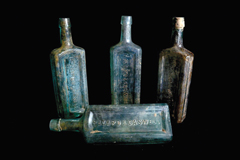 NEW HAMPSHIRE: As might be expected, archaeologists excavating the privy of a 19th-century house located on the campus of Dartmouth College discovered preserved human waste. What was surprising was that the property’s wealthy owners suffered from parasitic tapeworms, a condition usually afflicting individuals of lower socioeconomic status. The homeowners did, however, have the means to seek a remedy. Among the toilet’s debris were 12 medicinal bottles from a Rhode Island apothecary that marketed a cure for digestive ailments.
NEW HAMPSHIRE: As might be expected, archaeologists excavating the privy of a 19th-century house located on the campus of Dartmouth College discovered preserved human waste. What was surprising was that the property’s wealthy owners suffered from parasitic tapeworms, a condition usually afflicting individuals of lower socioeconomic status. The homeowners did, however, have the means to seek a remedy. Among the toilet’s debris were 12 medicinal bottles from a Rhode Island apothecary that marketed a cure for digestive ailments. -
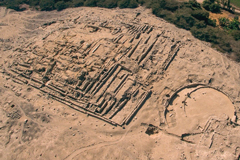 PERU: The culture that inhabited the Supe Valley between 3000 and 2000 B.C. is often considered the first city-building civilization in the Americas, having established urban centers with monumental pyramids and circular plazas. A recent project has determined that the location and orientation of these buildings was influenced by annual astronomical events—especially the moonrise’s southernmost position on the horizon—which coincided with cyclical changes such as the arrival of the rainy season, the beginning of winter, or the start of the planting season.
PERU: The culture that inhabited the Supe Valley between 3000 and 2000 B.C. is often considered the first city-building civilization in the Americas, having established urban centers with monumental pyramids and circular plazas. A recent project has determined that the location and orientation of these buildings was influenced by annual astronomical events—especially the moonrise’s southernmost position on the horizon—which coincided with cyclical changes such as the arrival of the rainy season, the beginning of winter, or the start of the planting season. -
 ENGLAND: Authorities today have technological tools at their disposal to help identify forged documents. Hundreds of years ago, English officials had at least one—sheepskin. Analysis of hundreds of historical legal documents revealed that beginning in the 13th century, sheepskin parchment was overwhelmingly preferred by lawyers to calfskin or goatskin. Because of sheepskin’s high fat content and unique texture, any attempt to erase or change what was written on it left visible blemishes and obvious signs that fraud might have been committed.
ENGLAND: Authorities today have technological tools at their disposal to help identify forged documents. Hundreds of years ago, English officials had at least one—sheepskin. Analysis of hundreds of historical legal documents revealed that beginning in the 13th century, sheepskin parchment was overwhelmingly preferred by lawyers to calfskin or goatskin. Because of sheepskin’s high fat content and unique texture, any attempt to erase or change what was written on it left visible blemishes and obvious signs that fraud might have been committed. -
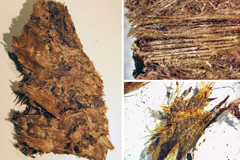 SWEDEN: Excavations over the past two centuries have shown that Viking warriors were often buried with supplies to aid them on their journey to the afterlife: weapons, tools, food, and cooking utensils. Two high-status men entombed at the site of Valsgärde during the 7th century had their voyage eased even further. They were buried with down-stuffed pillows and bedding, the oldest evidence of its kind yet found in Scandinavia. Feathers from a variety of species were used, including ducks, geese, chickens, grouse, and even eagle owls.
SWEDEN: Excavations over the past two centuries have shown that Viking warriors were often buried with supplies to aid them on their journey to the afterlife: weapons, tools, food, and cooking utensils. Two high-status men entombed at the site of Valsgärde during the 7th century had their voyage eased even further. They were buried with down-stuffed pillows and bedding, the oldest evidence of its kind yet found in Scandinavia. Feathers from a variety of species were used, including ducks, geese, chickens, grouse, and even eagle owls. -
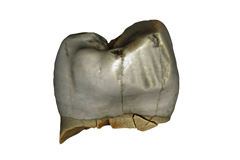 POLAND: Good oral hygiene was not invented by modern-day dentists, but rather has been practiced for tens of thousands of years—and not just by Homo sapiens. Enhanced imaging of a 46,000-year-old Neanderthal tooth recovered from Stajnia Cave revealed that the upper premolar had a distinctive groove worn into it. This was likely caused by a thin cylindrical object such as a bone or wooden toothpick that was used repeatedly to clean the area and remove food residue.
POLAND: Good oral hygiene was not invented by modern-day dentists, but rather has been practiced for tens of thousands of years—and not just by Homo sapiens. Enhanced imaging of a 46,000-year-old Neanderthal tooth recovered from Stajnia Cave revealed that the upper premolar had a distinctive groove worn into it. This was likely caused by a thin cylindrical object such as a bone or wooden toothpick that was used repeatedly to clean the area and remove food residue. -
 NIGERIA: The Nok people of central Nigeria are well known for their terracotta figurines and early ironworking capabilities. They were also perhaps the earliest systematic collectors of honey in West Africa, which they possibly used for nutritional and medicinal purposes. The presence of beeswax was detected in a number of clay pots, some dating to 1500 B.C. The Nok may have used the vessels as hives, to heat waxy honeycombs in order to extract the honey, or to produce honey-based alcoholic beverages.
NIGERIA: The Nok people of central Nigeria are well known for their terracotta figurines and early ironworking capabilities. They were also perhaps the earliest systematic collectors of honey in West Africa, which they possibly used for nutritional and medicinal purposes. The presence of beeswax was detected in a number of clay pots, some dating to 1500 B.C. The Nok may have used the vessels as hives, to heat waxy honeycombs in order to extract the honey, or to produce honey-based alcoholic beverages. -
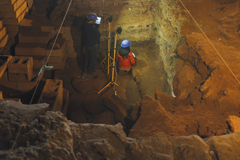 SOUTH AFRICA: New dating of sediments from the Kalahari Desert’s Wonderwerk Cave suggests the shelter may be the oldest home ever inhabited by our human ancestors. Researchers believe the cave was occupied as long as 1.8 million years ago—the presence of hominins is indicated by the remains of primitive stone tools. Burned bone and ashes also found at the site may be the earliest known evidence of deliberate use of fire, around a million years ago.
SOUTH AFRICA: New dating of sediments from the Kalahari Desert’s Wonderwerk Cave suggests the shelter may be the oldest home ever inhabited by our human ancestors. Researchers believe the cave was occupied as long as 1.8 million years ago—the presence of hominins is indicated by the remains of primitive stone tools. Burned bone and ashes also found at the site may be the earliest known evidence of deliberate use of fire, around a million years ago. -
 SAUDI ARABIA: An aerial survey recorded more than 1,000 enigmatic rectangular complexes scattered throughout the deserts of northwest Saudi Arabia. First appearing around 7,000 years ago, these huge structures, known as mustatils, are among the earliest known large-scale stone monuments found anywhere, predating even Egypt’s pyramids and Stonehenge. Scholars are unsure why they were constructed, but suggest they were used for religious ceremonies, since the remains of horned animals, especially cattle, are known to have been ritually deposited within them.
SAUDI ARABIA: An aerial survey recorded more than 1,000 enigmatic rectangular complexes scattered throughout the deserts of northwest Saudi Arabia. First appearing around 7,000 years ago, these huge structures, known as mustatils, are among the earliest known large-scale stone monuments found anywhere, predating even Egypt’s pyramids and Stonehenge. Scholars are unsure why they were constructed, but suggest they were used for religious ceremonies, since the remains of horned animals, especially cattle, are known to have been ritually deposited within them. -
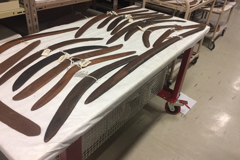 AUSTRALIA: The boomerang may be Australia’s most recognizable cultural artifact. After being hurled, the crescent-shaped hardwood objects will, hypothetically, return to the thrower. While Aboriginal communities have been using boomerangs for hunting and fighting for millennia, new research indicates they had other purposes as well. Microscopic analysis of wear patterns on more than 100 boomerangs from sites across the continent suggests they were frequently used to shape stone tools. They could also have been used for making fire or playing music, or as digging implements.
AUSTRALIA: The boomerang may be Australia’s most recognizable cultural artifact. After being hurled, the crescent-shaped hardwood objects will, hypothetically, return to the thrower. While Aboriginal communities have been using boomerangs for hunting and fighting for millennia, new research indicates they had other purposes as well. Microscopic analysis of wear patterns on more than 100 boomerangs from sites across the continent suggests they were frequently used to shape stone tools. They could also have been used for making fire or playing music, or as digging implements.
Advertisement
IN THIS ISSUE
Digs & Discoveries
A Challenging World
The Spider's on the Wall
Mirror, Mirror
Return to Sender
The Copper Standard
Red Carpet Treatment
Buddhist Retreat
Tubman's Training Ground
Anchors Aweigh
In the Anatolian Arena
Lost Egyptian City
Laws of the Land
Bathing at the Bar
Off the Grid
Around the World
Ancient Australian multi-tools, Africa’s oldest house, Neanderthal hygiene, and Viking warrior bedding
Artifact
All wonders great and small
Advertisement

Recent Issues
-
 May/June 2024
May/June 2024
-
 March/April 2024
March/April 2024
-
 January/February 2024
January/February 2024
-
 November/December 2023
November/December 2023
-
 September/October 2023
September/October 2023
-
 July/August 2023
July/August 2023
-
 May/June 2023
May/June 2023
-
 March/April 2023
March/April 2023
-
 January/February 2023
January/February 2023
-
 November/December 2022
November/December 2022
-
 September/October 2022
September/October 2022
-
 July/August 2022
July/August 2022
-
 May/June 2022
May/June 2022
-
 March/April 2022
March/April 2022
-
 January/February 2022
January/February 2022
-
 November/December 2021
November/December 2021
-
 September/October 2021
September/October 2021
-
 July/August 2021
July/August 2021
-
 May/June 2021
May/June 2021
-
 March/April 2021
March/April 2021
-
 January/February 2021
January/February 2021
-
 November/December 2020
November/December 2020
-
 September/October 2020
September/October 2020
-
 July/August 2020
July/August 2020
-
 May/June 2020
May/June 2020
-
 March/April 2020
March/April 2020
-
 January/February 2020
January/February 2020
-
 November/December 2019
November/December 2019
-
 September/October 2019
September/October 2019
-
 July/August 2019
July/August 2019
-
 May/June 2019
May/June 2019
-
 March/April 2019
March/April 2019
-
 January/February 2019
January/February 2019
-
 November/December 2018
November/December 2018
-
 September/October 2018
September/October 2018
-
 July/August 2018
July/August 2018
-
 May/June 2018
May/June 2018
-
 March/April 2018
March/April 2018
-
 January/February 2018
January/February 2018
-
 November/December 2017
November/December 2017
-
 September/October 2017
September/October 2017
-
 July/August 2017
July/August 2017
-
 May/June 2017
May/June 2017
-
 March/April 2017
March/April 2017
-
 January/February 2017
January/February 2017
-
 November/December 2016
November/December 2016
-
 September/October 2016
September/October 2016
-
 July/August 2016
July/August 2016
-
 May/June 2016
May/June 2016
-
 March/April 2016
March/April 2016
-
 January/February 2016
January/February 2016
-
 November/December 2015
November/December 2015
-
 September/October 2015
September/October 2015
-
 July/August 2015
July/August 2015
-
 May/June 2015
May/June 2015
-
 March/April 2015
March/April 2015
-
 January/February 2015
January/February 2015
-
 November/December 2014
November/December 2014
-
 September/October 2014
September/October 2014
-
 July/August 2014
July/August 2014
-
 May/June 2014
May/June 2014
-
 March/April 2014
March/April 2014
-
 January/February 2014
January/February 2014
-
 November/December 2013
November/December 2013
-
 September/October 2013
September/October 2013
-
 July/August 2013
July/August 2013
-
 May/June 2013
May/June 2013
-
 March/April 2013
March/April 2013
-
 January/February 2013
January/February 2013
-
 November/December 2012
November/December 2012
-
 Sep/Oct 2012
Sep/Oct 2012
-
 September/October 2012
September/October 2012
-
 July/August 2012
July/August 2012
-
 May/June 2012
May/June 2012
-
 March/April 2012
March/April 2012
-
 January/February 2012
January/February 2012
-
 November/December 2011
November/December 2011
-
 September/October 2011
September/October 2011
-
 July/August 2011
July/August 2011
-
 May/June 2011
May/June 2011
-
 March/April 2011
March/April 2011
-
 January/February 2011
January/February 2011
Advertisement






